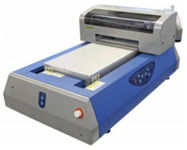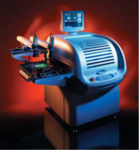Description of the organisation
DRACULA Technologies is a start-up company created in 2011, which is aimed at designing and manufacturing flexible photovoltaic (PV) solutions with their specific electronic to power nomad devices. H2020-NMBP-07-2017
The company was created as a result from the collaborative French project SOLARJET (FUI with two companies and an academic partner: ARDEJE, Hutchinson and CEA-INES, from 2008 to 2011, eligible budget: 2,280 M€) aiming at developing and manufacturing low cost printed PV cells. The company currently commercializes the first generation of flexible photovoltaic solutions called DRACULA POWER (inorganic photoactive materials) and develops, at the same time, the second generation of flexible photovoltaic solution based on organic and hybrid materials. The company has currently 6 persons as salaried employees.
Significant infrastructure / major items of technical equipment
Since its creation, DRACULA TECHNOLOGIES has invested in equipment to be at the cutting edge of technology. This equipment is described hereafter focused on those that will be used for the needs of MMAMA project. For most of the tasks involving DRACULA TECHNOLOGIES the sheet-to-sheet pilot line will be used. The layers applicator is PC controlled (speed, rate, start point, end point). Currently, the maximum layer dimensions that can be produced with this equipment 5*5 and 10*10 cm². The goal of DRACULA TECHNOLOGIES is to reach a surface of 30*30 cm². DRACULA TECHNOLOGIES uses a solar simulator for industrial and laboratory applications requiring an intense and very stable light source. Two types of filters are available:
- Air Mass filters precisely reproducing the terrestrial solar spectrum;
- UV filters (UVA or UVA + UVB) to obtain the maximum UV radiation responsible for aging.
In the framework of the development of OPV cells and modules, DRACULA TECHNOLOGIES prefers using Air Mass Filters making possible to reproduce precisely the terrestrial solar spectrum. It is particularly suitable for testing photovoltaic cells or solar collectors.
Main contact
Main publications related to the project
Publications
- 1. Towards high-temperature stability of PTB7-based bulk heterojunction solar cells: impact of fullerene size and solvent additive. S. Ben Dkhil, M. Pfannmöller, M.I. Saba, M. Gaceur, H. Heidari, C. Videlot Ackermann, O. Margeat, A. Guerrero, J. Bisquert, G. Garcia-Belmonte, A. Mattoni, S. Bals, J. Ackermann. Adv Energ. Mat., (2016), 1601486/1-11.
- 2. Square-centimeter-sized high-efficiency polymer solar cells: How the processing atmosphere and film quality influence performance at large scale. S. Ben Dkhil, M. Pfannmöller, S. Bals, T. Koganezawa, N. Yoshimoto, D. Hannani, M. Gaceur, C. Videlot-Ackermann, O. Margeat, J. Ackermann, Adv. Energ. Mat., (2016), 1600290/1-10.
- 3. New insights into morphology evolution of small molecule blends during solvent vapor annealing towards improved photocurrent generation. S. Ben Dkhil, M. Pfannmöller, I. Ata, D. Duché, M. Gaceur, T. Koganezawa, N. Yoshimoto, J.-J. Simon, L. Escoubas, C. Videlot-Ackermann, O. Margeat, S. Bals, P. Bäuerle, J. Ackermann. J. Mat. Chem. A. 5 (2017) 1005.
- 4. Customized free-form OPV modules: key to success. B. Cruchon, P. Pierron, C. Mercier, B., Ruhstaller, L. Penninck, T. Offermans, S. Fricke, D. Duché, L. Escoubas, J.-J. Simon. Photovoltaic Technical Conference “From advanced materials and processes to innovative applications” (2017).
Patents
- 1. Patent FR3023120 (A1) - Dispositif électroluminescent et son procédé de fabrication - 2016-01-01
- 2. Patent FR3023063 (A1) - Dispositif photovoltaïque et son procédé de fabrication - 2016-01-01
- 3. Patent EP2960957 (A1) – Photovoltaic device and method for making same - 2015-12-30
Key people involved
M. Brice Cruchon (Male), CEO.








